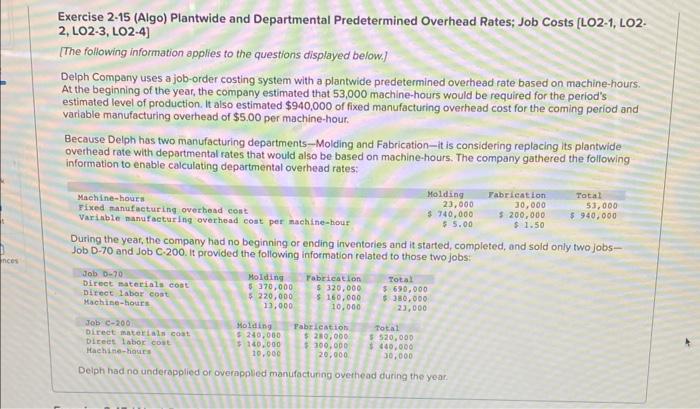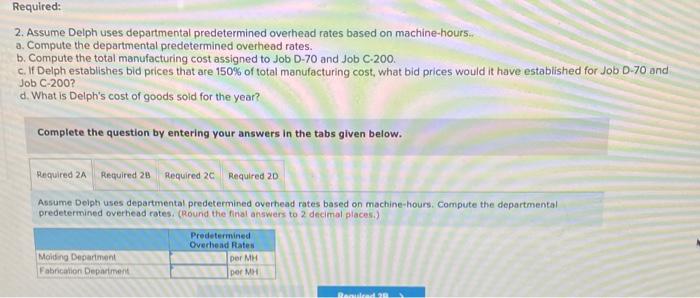2. Assume Delph uses departmental predetermined overhead rates based on machine-hours. a. Compute the departmental predetermined overhead rates. b. Compute the total manufacturing cost assigned to Job D-70 and Job C.200. c. If Delph establishes bid prices that are 150% of total manufacturing cost, what bid prices would it have established for Job D-70 and Job C-200? d. What is Delph's cost of goods sold for the year? Complete the question by entering your answers in the tabs given below. Assume Deiph uses departmental predetermined overhead rates based on machine-hours. Compute the departmental predetermined overhead rates. (Round the final answers to 2 decimal places.) Assume Delph uses departmental predetermined overhead rates based on machine-hours. If are 150% of total manufacturing cost, what bid prices would it have established for Job D-70 intermediate calculations to 2 decimal places. Round your final answers to nearest whole dolla Assume Delph uses departmental predetermined overhead rates based on machinefor the year? (Round your intermediate calculations to 2 decimal places. Round your amount.) Assume Delph uses departmental predetermined overhead rates based on machine-hours. cost assigned to Job D-70 and Job C-200. (Round your intermediate calculations to 2 decimal answers to nearest whole dollar amount.) Exercise 2-15 (Algo) Plantwide and Departmental Predetermined Overhead Rates; Job Costs [LO2-1, LO2. 2, LO2-3, LO2-4] [The following information applies to the questions displayed below.] Delph Company uses a job-order costing system with a plantwide predetermined overhead rate based on machine-hours. At the beginning of the year, the company estimated that 53,000 machine-hours would be required for the period's estimated level of production. It also estimated $940,000 of fixed manufacturing overhead cost for the coming period and variable manufacturing overhead of $5.00 per machine-hour. Because Delph has two manufacturing departments - Molding and Fabrication-it is considering replacing its plantwide overhead rate with departmental rates that would also be based on machine-hours. The company gathered the following information to enable calculating departmental overhead rates: During the year, the company had no beginning or ending inventories and it started, completed, and sold only two jobs Job D-70 and Job C.200. It provided the following information related to those two jobs: Delph had no underapplied or overapplied manufacturng overhead during the year











